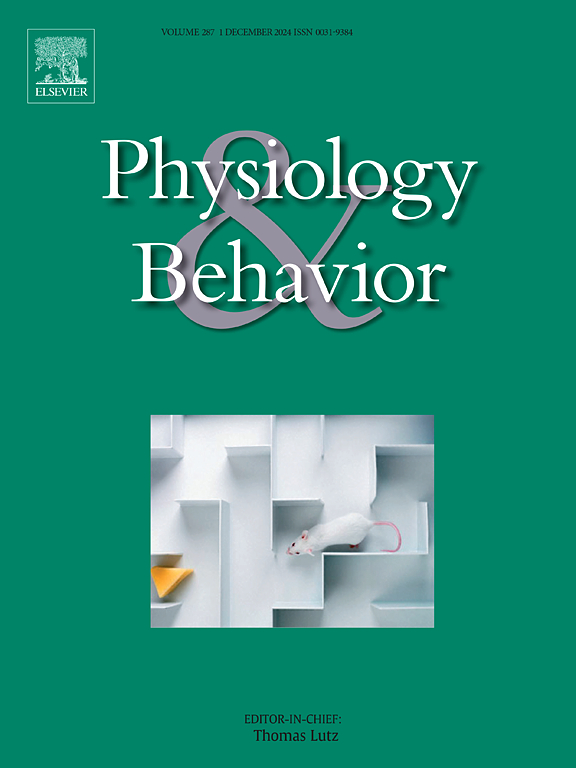青少年吗啡暴露对脑刺激、奖励敏感性和多巴胺神经元兴奋性的影响。
IF 2.5
3区 医学
Q2 BEHAVIORAL SCIENCES
引用次数: 0
摘要
青少年滥用药物会导致奖励处理和决策的持久变化。为了确定阿片类药物治疗和戒断对青春期奖励敏感性的影响,我们在青春期大鼠中使用了频率(RF)颅内自我刺激(ICSS)范式。在PD28,在下丘脑外侧水平的内侧前脑束植入刺激电极,每天训练两次,以执行为青少年定制的变体RF ICSS任务。每天从PD45-51开始注射吗啡(5mg /kg)或生理盐水(0.5 ml/kg),在AM ICSS阶段之前,我们继续进行PD60阶段以测量戒断。然后对大鼠进行标准成人RF ICSS任务的训练。所有动物从PD90-96开始进行测试,同时每天给予吗啡(10mg/kg)和另外9天的停药。在青少年对照组中,奖励敏感性在基线、注射和注射后阶段都是稳定的。与对照组相比,青少年吗啡给药导致了奖励敏感性的显著增加,随后在整个9天的戒断期内,奖励敏感性持续下降。相对于那些在青春期没有接触过吗啡的人,在成年期再次接触吗啡会导致在给药期间更大的敏感性增加和更深刻的戒断抑制。在另一组单独的动物中,戒除青少年吗啡治疗导致腹侧被盖区多巴胺神经元的电生理兴奋性降低,这可能有助于奖励敏感性的持久改变。青春期吗啡暴露后的这种改变可能会导致成年后对适应不良行为的易感性。本文章由计算机程序翻译,如有差异,请以英文原文为准。
Effects of adolescent morphine exposure on brain stimulation reward sensitivity and dopamine neuron excitability
Adolescent substance abuse drives lasting changes in reward processing and decision making. To determine the effects of opioid treatment and withdrawal on reward sensitivity during adolescence, we used a rate-frequency (RF) intracranial self-stimulation (ICSS) paradigm in adolescent rats. On PD28, rats were implanted with stimulating electrodes in the medial forebrain bundle at the level of the lateral hypothalamus and trained twice-daily to perform a variant RF ICSS task tailored for adolescents. Morphine (5 mg/kg) or saline (0.5 ml/kg) was injected daily prior to the AM ICSS session from PD45–51 and we continued to perform sessions through PD60 to measure withdrawal. Rats were then trained on a standard adult RF ICSS task. All animals were tested from PD90–96 while undergoing daily morphine administration (10mg/kg) and for an additional 9 days of withdrawal. In adolescent controls, reward sensitivity was stable across baseline, injection, and post-injection sessions. Adolescent morphine administration resulted in a significant increase in reward sensitivity relative to controls followed by a reduction lasting for the entire 9-day withdrawal period. Re-exposure to morphine in adulthood resulted in a greater increase in sensitivity during administration and a more profound suppression in withdrawal relative to those that had not been exposed to morphine in adolescence. In a separate group of animals, withdrawal from adolescent morphine treatment resulted in reduced electrophysiological excitability of ventral tegmental area dopamine neurons that may contribute to lasting alterations in reward sensitivity. Such alterations following adolescent morphine exposure may drive susceptibility to maladaptive behaviors in adulthood.
求助全文
通过发布文献求助,成功后即可免费获取论文全文。
去求助
来源期刊

Physiology & Behavior
医学-行为科学
CiteScore
5.70
自引率
3.40%
发文量
274
审稿时长
47 days
期刊介绍:
Physiology & Behavior is aimed at the causal physiological mechanisms of behavior and its modulation by environmental factors. The journal invites original reports in the broad area of behavioral and cognitive neuroscience, in which at least one variable is physiological and the primary emphasis and theoretical context are behavioral. The range of subjects includes behavioral neuroendocrinology, psychoneuroimmunology, learning and memory, ingestion, social behavior, and studies related to the mechanisms of psychopathology. Contemporary reviews and theoretical articles are welcomed and the Editors invite such proposals from interested authors.
 求助内容:
求助内容: 应助结果提醒方式:
应助结果提醒方式:


